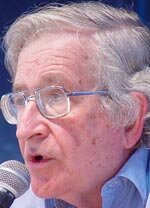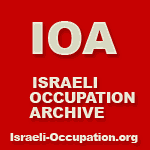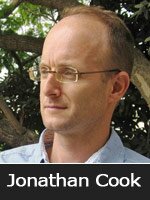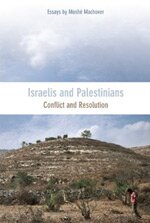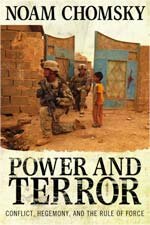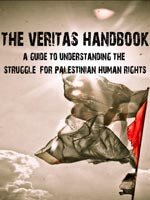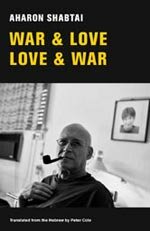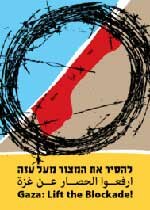Paul Jay of The Real News Network interviews Lia Tarachansky – Apr 6-7, 2011
Part I: http://therealnews.com/t2/index.php?option=com_content&task=view&id=31&Itemid=74&jumival=6512
Part II: http://therealnews.com/t2/index.php?option=com_content&task=view&id=31&Itemid=74&jumival=6532
Lia Tarachansky about how she went from growing up in an Israeli settlement to reporting on the Middle East for TRNN.
Part I
Paul Jay interviews Lia Tarachansky, The Real News Middle East correspondent. Tarachansky covers the political economy of the occupation, while also focusing on international law and its applicability to the conflict. Having grown up in an Israeli settlement in the heart of the occupied West Bank, Tarachansky speaks about how denial of narrative fuels a conflict where the two peoples, the Israelis and Palestinians, become further segregated, physically, socially, and psychologically.
Part II
In the second part of Paul Jay’s interview with Lia Tarachansky, she talks about the stories she produced while working for The Real News Network in the Middle East. While in the region, Tarachansky investigated who benefits from the occupation and attempted to provide context for the news. Now, she is heading back to the region to establish a permanent base on the ground, working with both Israeli and Palestinian journalists to dedicated to independent media.
Bio
Lia Tarachanskyis an Israeli-Canadian journalist with The Real News Network covering the Middle East. She is also currently working on her first documentary, Seven Deadly Myths, a Journeyman Pictures co-production.
Part I Transcript
PAUL JAY: Welcome to The Real News Network. I’m Paul Jay in Washington. Lia Tarachansky covered Israel and Palestine for The Real News Network for ten months last year, and she’s about to go back. Now joining us from Ottawa, about to get on an airplane for Israel and Palestine, is Lia Tarachansky. Thanks for joining us, Lia.
LIA TARACHANSKY: Thanks, Paul.
JAY: So most of our viewers have watched your material, I’m sure, with great interest, but they don’t know very much about you. So why don’t you just tell us a little bit about your background, and then how you came to doing journalism about the Middle East?
TARACHANSKY: I came to Israel in the 1991 immigration from the former Soviet Union, along with 1 million other Russians. And as part of that immigration, we were one of the biggest populations to move to the West Bank to settle in the growing settlements in the mid ’90s during the–what’s known as the Oslo years, the beginning of the peace negotiations. So I grew up on a settlement in the occupied West Bank, and about a decade ago we moved to Canada and started writing quite a bit. And then The Real News took me to Toronto and trained me in video production.
JAY: Now, I was with you in Israel a few months ago, and we went back to the settlement you grew up in. And there was a moment there where you looked out from between the houses and you saw a Palestinian village. Talk a bit about that moment.
TARACHANSKY: Sure. You had the great misfortune to capture me in one of the most emotionally charged moments I had. And the whole settlement is sort of like a giant amoeba resting on a huge hill. And we go to the highest point and we overlook it, and we just sort of said something along the lines of why don’t we do a quick throw and say, “I’m Lia Tarachansky, I work for The Real News,” you know, “this is where I grew up”? And while we’re in the middle of doing this, you know, I stand up, and all of a sudden–I don’t know if you remember this, but the call to prayer starts. And I suddenly realize, as I’m looking in the camera and you were asking me all these questions, that it was the first time in my life that I was hearing this call to prayer. And so that started a very long process of thinking about how it is possible to grow up for years in the heart of the occupied Palestinian territories and never factor in that there are Palestinians everywhere. I mean, we grow up knowing that there’s The Enemy everywhere (capital T, capital E), but we never think of it as the people that make up The Enemy. So it’s not only a denial through politics; it’s such a deep psychological denial that we physically don’t see or don’t hear, or at least I didn’t, until [inaudible] gone back.
JAY: And just–again, so people get the geographic picture, it’s not that you couldn’t look up and see them. It’s as you said at the moment: it’s like they’re invisible. It’s not that they’re not there to be seen.
TARACHANSKY: Sure. And I think the same thing is true on the other side, because most Palestinians in the Palestinian territories have never seen an Israeli just exist. They’ve seen soldiers, some of them have seen settlers, but they’ve never seen, you know, like, a Jewish person or an Israeli person just go to the store or play in a kindergarten or, you know, buy groceries. They’ve never seen the normalized Israeli. So in their mind, as far as I understand from speaking to Palestinians, that is also an entire context that’s missing.
JAY: And part of that is because a lot of the settlements have these settler-only roads between settlements to get back and forth to Israel proper that Palestinians are not allowed to. So you could–I guess you could live in a settlement, travel on those roads, and as you’re saying, never meet a Palestinian directly that lived in villages right next to you.
TARACHANSKY: Sure. And, I mean, in Ariel during the Oslo years, before the whole system of Apartheid roads became really solidified, we had to travel through Palestinian villages to get to Israel proper. And, of course, the adults, you know, did it for ideological reasons, for economic reasons, for historical reasons, but for us who grew up in these settlements, you grow up and you never factor in the humanity of the other. And that’s very important if you’re going to produce a nation of people who are willing and happy to go and serve in the army.
JAY: I remember when we were there I asked you, why do people hate each other, and you said you don’t think it’s that we hate each other; it’s both sides are afraid of each other.
TARACHANSKY: There is such a disconnect between the human beings that it’s more fear of the other. And when you rationalize the entire conflict, you boil it down to its facts, right? We talk to people, and you just talk about the facts, you know, intransigence and the failure of the negotiations. And it always ends at these big things like, well, how can we trust them? So these big questions. So it’s not even about the facts at the end of the day; it’s about these big metaphysical questions that have no answer.
JAY: Now, you’re going back in just a couple of weeks. What are you going to focus on? What–in this next seven-month gig in Israel and Palestine, what are you going to be looking for?
TARACHANSKY: Well, part of my assignment is to establish a permanent presence for The Real News in the Middle East. So I will be speaking to and training and trying to find Palestinian and Israeli journalists to carry on coverage of Israel-Palestine when I’m no longer there. But my main focus all along has been–from previous stories and will continue now, is to focus not only on filling in the context of the conflict, so how we end up in the conflict, but also talking about who benefits from the conflict, who’s building the settlements and the wall, and what are the–who are the people and what are the corporations that really benefit from the conflict continuing.
JAY: Now, I think one of the things we’re going to try to do differently this year is produce more of the stories in Hebrew, and perhaps Arabic as well, and do translations, so people in the region can watch the stories. But just to end up, what do you hope for people in North America and Europe that are watching? And what do you hope they see through your eyes? And then, what do you hope people in the region may see through your eyes?
TARACHANSKY: First of all, of course, one of the things that we always fight for on The Real News is context, is understanding why things happen. And I find that even amongst the community of the people who are very engaged with the conflict and very involved, there’s very, very shallow understanding of why things happen. So that’s number one. But besides that, the main point of what I’m trying to get at is that this situation in the Middle East is not exceptional. The reason it started, the reason it continues, and the people who benefit from this conflict, it’s almost insulting how typical it is in the methods and in the interests that are served. So one of the things we try to show by focusing on political economy is that these conflicts continue because it’s in the interests of business. And, for example, one of the stories I’ll be focusing on when I get there is the privatization of the occupation. So one of the stories I did about a year ago talks about how the Israeli military is trying to make as much of this conflict automatic as possible to minimize the human contact between the soldiers and the people that they’re occupying, the Palestinians.
JAY: This was the story you did, I think, with–titled “Remote control occupation”.
TARACHANSKY: With the Second Intifada over, Israel is changing its approach to the occupation through new technology. Israel’s annual military spending as a percentage of GDP outnumbers even that of the United States threefold, yet this figure does not even include the cost of the occupation, estimated at $9 billion a year. Most of Israel’s defence industry is owned by the government. However, Israel is looking to privatize the maintenance of the occupation and make it possible to maintain control remotely.
SHIR HEVER: The commanders of the army are the least interested in the boring minutia and details of controlling the checkpoints, controlling the daily lives of Palestinians. They’re much more excited about developing new offensive weapons, fancy aircraft, and that sort of thing. So they’re trying to find ways to save on manpower costs and to make the army, the military, more focused on actual fighting of wars. Occupation has changed the priorities of the Israeli military over years, and that was very apparent in 2006 in the war with Lebanon.
JAY: Thanks for joining us. And in the continuation of our interview with Lia, we’re going to talk more about the work she did over the last year when she was there and show you a little bit of it. Please join us again on The Real News Network.
End of Part I Transcript
Part II Transcript
Transcript
PAUL JAY: Welcome back to The Real News Network. I’m Paul Jay in Washington. We’re continuing our conversation with our Real News journalist who covers Israel and Palestine, is about to go back, Lia Tarachansky. Thanks for joining us again, Lia.
LIA TARACHANSKY: Thank you, Paul.
JAY: So talk to us about some of the stories. You produced many stories for us when you were there. But–so which ones jump out for you?
TARACHANSKY: The stories that jump out at me are the stories that are very much missing in the mainstream corporate media, stories that, for example, show the aftereffect of an incident. So while, you know, local media covers something that happens, we often cover what happens right afterwards, which is the most important part, the cannon fodder. One story particularly was after a settler was killed, and the entire corporate media was covering the death of the settler. Something similar just happened with a family of five in the settlement of /”i.t@.mAl/. But what was missing was the complete invasion and shutting down of the West Bank, the invasion of the city of Nablus, and the assassination of three Palestinians.
TARACHANSKY: On the night of December 26, dozens of Israeli Army jeeps and bulldozers occupied the streets of the Old City in Nablus. Witnesses reported that more than 70 soldiers were involved in the raid operation. The Real News spoke to Tahani Sarkaji, Raed Sarkaji’s wife, who witnesses the raid during which he was assassinated.
TARACHANSKY: Other stories are political economy stories that investigate who benefits from the conflict, specifically what people and what companies benefit from privatizing the occupation.
TARACHANSKY: The family is listed in the Israeli daily Haaretz list of 100 most influential people in Israel. Besides its investment in AHAVA, the Livnat family profits in various ways from the economy of the occupation. The Livnat family sits on the board of IDB Holdings Corporation, Israel’s largest investment conglomerate. Many of the family’s subsidiaries and firms are also part of the IDB enterprise. Many benefit directly from the occupation by either placing their factories in the West Bank or building the infrastructure of the settlement network. For example, some of the Livnat family’s biggest investments are in agricultural firms that grow produce in the West Bank and the occupied Golan Heights. Their IDB companies also produce cement for the construction of the segregation wall.
TARACHANSKY: And also stories that really paint a context. So, for example, we did a story that investigates specifically the methodology behind how settlers take over Palestinian land. So how they go, they establish an outpost, exactly how that outpost grows into a settlement, how the government interacts with that outpost, how they get set up with electricity and water, etc., and how they manage to grow and take more land and more land. So the stories that really fill in the blanks that the corporate mainstream media leaves behind.
JAY: I thought one of the stories that I thought was most interesting was one we did about a town that’s sort of leading the way in a new form of resistance or civil disobedience. Talk a bit about that.
TARACHANSKY: Sure. Well, Palestinian nonviolent resistance has been going on for decades. And, actually, Palestinian leaders such as Marwan Barghouti have been calling for a boycott, you know, decades ago. So–but now we see global coverage of that nonviolent resistance through villages like Bil’in, which is a fairly famous village at this point that has a weekly protest against the Segregation Fence. And, actually, the Israeli high court, Supreme Court, actually voted in favor of that village. But the army refuses to abide by the Supreme Court ruling. So I did a story that looks at how Bil’in is at the center of this mass nonviolent movement. And if you look at the West Bank now, every week, usually around the weekends, there’s weekly protests that go on for years. So Bil’in has been going on for six years now, I believe, where every single Friday the village protests the wall, and every single Friday they get shot at by tear gas and water cannons and rubber bullets or real bullets by the Army. So this village is sort of at the center of a nonviolent resistance that’s really flourishing throughout the West Bank.
JAY: And to what extent–when you say “really flourishing”, how much is that developing? And I guess one of the things you might want to be covering when you go back is the consequences or effect of the uprising across the whole Arab world and how this is affecting the Palestinian struggle. Do you get some sense of that yet?
TARACHANSKY: I think that the repression, the Israeli repression of nonviolent resistance has been going on for–you know, since as long as it’s been–the nonviolent resistance has been going on. But one shift that we’ve seen is that because of Israeli noncooperation, Israeli activists cooperating in solidarity with this resistance, what we’re seeing now is a new wave of Israeli repression of Israeli nonviolent activists. And that’s been really increasing in the past six months to a point where Israeli activists have their houses raided, they get called by the Israeli intelligence, they get interrogated. So that’s new. I think that the uprisings in the Arab world sort of leave most Israelis in the dark, because I think most Israelis have never considered the possibility that the Arab people that live around them are, first of all, all different nationalities and communities and they want different things, and they’re not some big monolith of the Arab world countries. And, also, I don’t think that Israelis really consider that these people have–you know, really passionately want democracy. I think that the stereotypes we’ve internalized about the Arab world don’t include the democratic movement. So I think that these democratic movements from Tunisia to Algeria, Libya, you know, Egypt, etc., are going to really open the eyes of a lot of Israelis. And I don’t know what effect that’s going to have on the nonviolent resistance, but what I do know is that when I returned to Israel and started working for The Real News, I would go to the weekly protests also in East Jerusalem, in neighborhoods like Sheikh Jarrah, and it would be 200 people, and by the time I left Israel the last time, there would be 1,000 people. So this movement is growing. And what’s really inspiring is that this is a persistent movement of Israelis and Palestinians working hand-in-hand in complete solidarity, and they are relentless. They go week in and week out, every single Friday, every single Saturday, every single Sunday, and they protest every single week, despite the constant repression.
JAY: How do you assess other coverage of the Israeli-Palestinian issues?
TARACHANSKY: One thing I think the mainstream media really fails at doing is demonstrating the daily occupation and the daily life in Israel with the constant militarism that our society is undergoing. And by hiring a local Israeli journalist and a local Palestinian journalist, I think The Real News is really breaking through a wall that the mainstream media always seems to hit its head against, which is trusting the native people that live in the land to cover their own society. And I think that only an Israeli and a Palestinian journalist can really understand the inside of the reality of their life and the political map to really cover the region in a way that portrays what that conflict looks like on a daily basis. And mainstream journalists, you know, they typically get flown into Israel, they stay in Jerusalem for three, maybe, months, at most four months, and they go on these short assignments to the territories or to Israel, and they never really build any relationships with the local people on the ground that really demonstrate and in some ways empower those people to represent their own society for themselves. So I think that that’s–.
JAY: There’s another angle, too, which–as the American networks have so clearly internalized the idea of American national interest as a starting point for these issues and this sort of alliance with Israel, Al Jazeera, which on the whole does, you know, more interesting work, I think, than the mainstream US networks, still, it’s owned by the emir of Qatar, and Qatar’s a player in the region, and there’s been a lot of critique about how they’re covering Bahrain, and one has to keep it in mind. Russia Today, clearly it likes to critique just about anything American and has a certain amount of Russian interest in mind.
TARACHANSKY: Being independent means that when out and covering the conflict, I don’t need to worry about having our funding cut off when I’m calling in an occupation or when I’m showing what the Israeli army does after an incident happens, and I think that that’s very, very important, especially because of the way that the conflict currently is portrayed is always from the point of view of Western interests and not from the point of view of the fodder, the cannon fodder, the effect of those interests on the people on the ground.
JAY: Well, thanks very much for joining us, Lia.
TARACHANSKY: Thank you, Paul.
JAY: And if you want to see more of Lia’s work, it’s all down here below the player in a collection. And if you’d like to see more work from the Middle East, don’t forget the donate buttons here, because for Lia to go do that, you’ve got to punch this. Thanks for joining us.
End of Transcript
More at The Real News




















